
Trillium erectum, the red trillium, also known as wake robin, purple trillium, bethroot, or stinking benjamin, is a species of flowering plant in the family Melanthiaceae. The plant takes its common name "wake robin" by analogy with the European robin, which has a red breast heralding spring. Likewise Trillium erectum is a spring ephemeral plant whose life-cycle is synchronized with that of the forests in which it lives. It is native to the eastern United States and eastern Canada from northern Georgia to Quebec and New Brunswick.
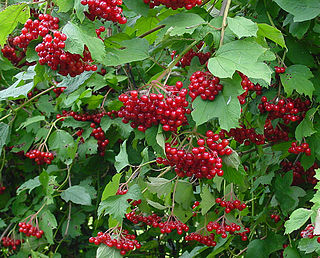
Viburnum is a genus of about 150–175 species of flowering plants in the moschatel family, Adoxaceae. Its current classification is based on molecular phylogeny. It was previously included in the honeysuckle family Caprifoliaceae.

Betula papyrifera is a short-lived species of birch native to northern North America. Paper birch is named after the tree's thin white bark, which often peels in paper-like layers from the trunk. Paper birch is often one of the first species to colonize a burned area within the northern latitudes, and is an important species for moose browsing. Primary commercial uses for paper birch wood are as boltwood and sawlogs, while secondary products include firewood and pulpwood. It is the provincial tree of Saskatchewan and the state tree of New Hampshire.
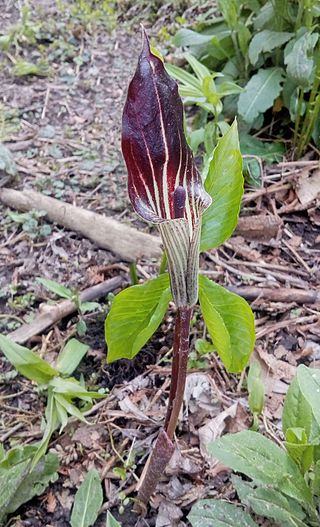
Arisaema triphyllum, the Jack-in-the-pulpit, is a species of flowering plant in the arum family Araceae. It is a member of the Arisaema triphyllum complex, a group of four or five closely related taxa in eastern North America. The specific name triphyllum means "three-leaved", a characteristic feature of the species, which is also referred to as Indian turnip, bog onion, and brown dragon.

Viburnum acerifolium, the mapleleaf viburnum, maple-leaved arrowwood or dockmackie, is a species of Viburnum, native to eastern North America from southwestern Quebec and Ontario south to northern Florida and eastern Texas. It is adapted for USDA hardiness zones of 4 to 8.

Hydrangea arborescens, commonly known as smooth hydrangea or sevenbark, is a species of flowering plant in the family Hydrangeaceae. It is a small- to medium-sized, multi-stemmed, deciduous shrub up to 2 m (7 ft) tall that is native to the eastern United States.

Ostrya virginiana, the American hophornbeam, is a species of Ostrya native to eastern North America, from Nova Scotia west to southern Manitoba and eastern Wyoming, southeast to northern Florida and southwest to eastern Texas. Populations from Mexico and Central America are also regarded as the same species, although some authors prefer to separate them as a distinct species, Ostrya guatemalensis. Other names include eastern hophornbeam, hardhack, ironwood, and leverwood.
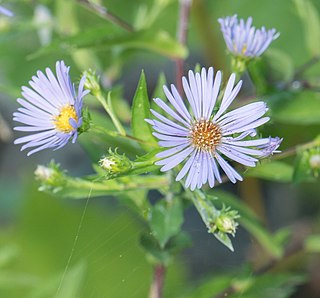
Symphyotrichum puniceum, is a species of flowering plant in the family Asteraceae native to eastern North America. It is commonly known as purplestem aster, red-stalk aster, red-stemmed aster, red-stem aster, and swamp aster. It also has been called early purple aster, cocash, swanweed, and meadow scabish.

Viburnum dentatum, southern arrowwood or arrowwood viburnum or roughish arrowwood, is a small shrub, native to the eastern United States and Canada from Maine south to northern Florida and eastern Texas.
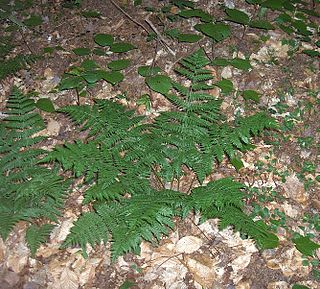
Dryopteris intermedia, the intermediate wood fern or evergreen wood fern, is a perennial, evergreen wood fern native to eastern North America. It is a diploid species, and is the parent of several species of hybrid origin, including Dryopteris carthusiana. Other common names for this species include intermediate shield fern, fancy wood fern, fancy fern, glandular wood fern, American shield fern and common wood fern.
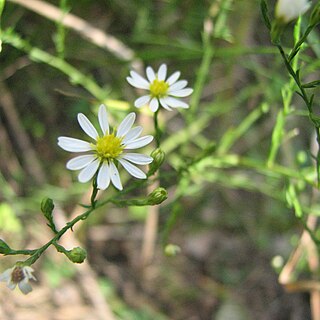
Symphyotrichum depauperatum, commonly known as serpentine aster or starved aster, is a rare species in the family Asteraceae adapted to serpentine barrens, an ecosystem with a high concentration of toxic metals in the soil. It has been found in Pennsylvania, Maryland, and on some diabase glades in North Carolina. It grows to 50 centimeters and has white ray florets surrounding a center of yellow disk florets.
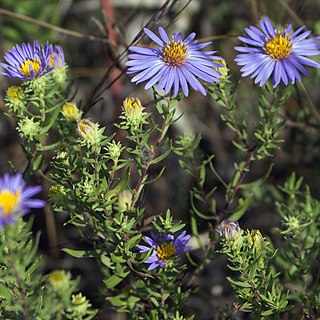
Symphyotrichum oblongifolium, commonly known as aromatic aster or oblong-leaved aster, is a species of flowering plant in the family Asteraceae and is native to parts of the eastern and central United States. It is an uncommon herbaceous perennial that reaches heights of 10–80 centimeters and blooms August–November with many flower heads in various shades of purple.

Eriophorum viridicarinatum is a species of sedge known by the common names thinleaf cottonsedge, green-keeled cottongrass, and bog cottongrass. It is native to Canada and the United States.

Viburnum rafinesqueanum, the downy arrowwood, is a deciduous medium-sized shrub native to the Eastern United States and Canada from Quebec and Manitoba south to Georgia and west to Oklahoma. Downy arrow-wood produces ornamental but slightly malodorous flowers in Spring.

Bidens hyperborea is a variable species of flowering plant in the family Asteraceae, known from estuarine regions in northeastern North America. It is similar to Bidens cernua, Bidens laevis, and Bidens eatonii. B. hyperborea is listed as an endangered species in the state of Massachusetts, where it is threatened by habitat degradation, and is listed by NatureServe as critically imperiled (S1) in the province of Ontario and possibly extirpated from New Hampshire.

Viburnum cassinoides, commonly known as northern wild raisin, blue haw, witherod viburnum, or swamp haw, is a deciduous shrub native to eastern North America in the viburnum family, Viburnaceae. It is often synonymized with Viburnum nudum var. cassinoides.

Gaylussacia bigeloviana, also known as the northern dwarf huckleberry or in French as the gaylussaquier de Bigelow, is a plant species native to the coastal plains of eastern Canada and the eastern United States. It grows from Newfoundland to South Carolina in swamps and marshes, including acidic bogs alongside Sphagnum peatmosses.
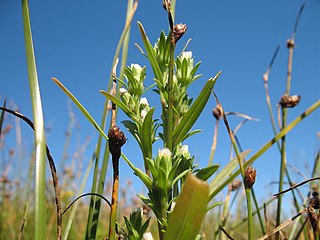
Symphyotrichum laurentianum is a critically imperiled species of flowering plant in the family Asteraceae endemic to the southern shores of the Gulf of St. Lawrence in Canada. Commonly known as Gulf of St. Lawrence aster, it is an annual, herbaceous plant with one stem and no ray florets that grows up to about 13 centimetres tall.

Tiarella stolonifera is a species of flowering plant in the family Saxifragaceae. The specific name stolonifera means "spreading by stolons", an important characteristic of this species. Known as the creeping foamflower, it has the widest range of any species of Tiarella in eastern North America.




















